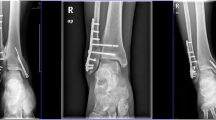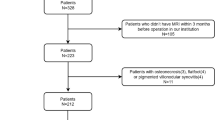Abstract
Background
Untreated ankle fractures with concomitant tibiofibular syndesmosis injury often lead to postoperative pain and early traumatic arthritis. CT has advantages in the preoperative diagnosis of combined ankle injuries. However, a few studies have investigated the best preoperative CT parameters to predict tibiofibular syndesmosis injuries associated with ankle fractures. This study aimed to identify and evaluate the optimal preoperative CT parameters for predicting tibiofibular syndesmosis injuries associated with ankle fractures.
Methods
We retrospectively analyzed 129 patients who underwent preoperative CT of an ankle fracture treated between January 2016 and April 2022 at a tertiary A hospital. All patients underwent open reduction and internal fixation and intraoperative stability testing. Based on the Cotton test, the patients were divided into the stable group (n = 83, 64.3%) and unstable group (n = 46, 35.7%). After 1:1 propensity score matching, the general conditions, anterior tibiofibular distance (TFD), posterior TFD, maximum TFD, tibiofibular syndesmosis area, sagittal fracture angle, Angle-A, and Angle-B were compared between the stable and unstable groups.
Results
The propensity score-matched cohort comprised 82 patients. There were no significant differences between the stable and unstable groups in sex, age, affected side, operation interval, injury mechanism, Lauge-Hansen classification, sagittal fracture angle, and Angle-A (all P > 0.05). Compared with the stable group, the unstable group had a significantly greater aTFD, pTFD, maxTFD, and area (all P < 0.05). PTFD, maxTFD, and area were positively correlated with joint instability. Angle-B was smaller in the unstable group (57.13°) than the stable group (65.56°). ROC analysis showed that Area (AUC 0.711) and maxTFD (AUC 0.707) had the highest diagnostic efficacy.
Conclusion
MaxTFD and Area were the best predictive parameters; a larger Area was associated with a higher likelihood of instability of the tibiofibular syndesmosis after ankle fracture fixation.



Similar content being viewed by others
Data availability
The authors state that the data in the article can be provided when needed.
References
Huang Q, Cao Y, Yang C, Li X, Xu Y, Xu X. Diagnosis of tibiofibular syndesmosis instability in Weber type B malleolar fractures. J Int Med Res. 2020;48(7):300060520939752.
Randell M, Marsland D, Ballard E, Forster B, Lutz M. MRI for high ankle sprains with an unstable syndesmosis: posterior malleolus bone oedema is common and time to scan matters. Knee Surg Sports Traumatol Arthrosc. 2019;27(9):2890–7.
Sman AD, Hiller CE, Refshauge KM. Diagnostic accuracy of clinical tests for diagnosis of ankle syndesmosis injury: a systematic review. Br J Sports Med. 2013;47(10):620–8.
Kellett JJ, Lovell GA, Eriksen DA, Sampson MJ. Diagnostic imaging of ankle syndesmosis injuries: A general review. J Med Imaging Radiat Oncol. 2018;62(2):159–68.
Yeung TW, Chan CY, Chan WC, Yeung YN, Yuen MK. Can pre-operative axial CT imaging predict syndesmosis instability in patients sustaining ankle fractures? Seven years’ experience in a tertiary trauma center. Skelet Radiol. 2015;44(6):823–9.
Szymanski T, Zdanowicz U. Comparison of routine computed tomography and plain X-ray imaging for malleolar fractures-How much do we miss? Foot Ankle Surg. 2022;28(2):263–8.
Lee SW, Lee KJ, Park CH, Kwon HJ, Kim BS. The valid diagnostic parameters in bilateral CT scan to predict unstable syndesmotic injury with ankle fracture. Diagnostics (Basel). 2020;10(10):812.
Ebraheim NA, Lu J, Yang H, Mekhail AO, Yeasting RA. Radiographic and CT evaluation of tibiofibular syndesmotic diastasis: a cadaver study. Foot Ankle Int. 1997;18(11):693–8.
Chun DI, Kim J, Kim YS, et al. Relationship between fracture morphology of lateral malleolus and syndesmotic stability after supination-external rotation type ankle fractures. Injury. 2019;50(7):1382–7.
Davidovitch RI, Weil Y, Karia R, et al. Intraoperative syndesmotic reduction: three-dimensional versus standard fluoroscopic imaging. J Bone Jt Surg Am. 2013;95(20):1838–43.
Malhotra G, Cameron J, Toolan BC. Diagnosing chronic diastasis of the syndesmosis: a novel measurement using computed tomography. Foot Ankle Int. 2014;35(5):483–8.
Hamard M, Neroladaki A, Bagetakos I, Dubois-Ferriere V, Montet X, Boudabbous S. Accuracy of cone-beam computed tomography for syndesmosis injury diagnosis compared to conventional computed tomography. Foot Ankle Surg. 2020;26(3):265–72.
Del Rio A, Bewsher SM, Roshan-Zamir S, et al. Weightbearing cone-beam computed tomography of acute ankle syndesmosis injuries. J Foot Ankle Surg. 2020;59(2):258–63.
Franke J, von Recum J, Suda AJ, Vetter S, Grutzner PA, Wendl K. Predictors of a persistent dislocation after reduction of syndesmotic injuries detected with intraoperative three-dimensional imaging. Foot Ankle Int. 2014;35(12):1323–8.
Sagi HC, Shah AR, Sanders RW. The functional consequence of syndesmotic joint malreduction at a minimum 2-year follow-up. J Orthop Trauma. 2012;26(7):439–43.
Rammelt S, Zwipp H, Grass R. Injuries to the distal tibiofibular syndesmosis: an evidence-based approach to acute and chronic lesions. Foot Ankle Clin. 2008;13(4):611–33.
Ogilvie-Harris DJ, Reed SC, Hedman TP. Disruption of the ankle syndesmosis: biomechanical study of the ligamentous restraints. Arthroscopy. 1994;10(5):558–60.
Clanton TO, Williams BT, Backus JD, et al. Biomechanical analysis of the individual ligament contributions to syndesmotic stability. Foot Ankle Int. 2017;38(1):66–75.
Jayatilaka MLT, Philpott MDG, Fisher A, Fisher L, Molloy A, Mason L. Anatomy of the insertion of the posterior inferior tibiofibular ligament and the posterior malleolar fracture. Foot Ankle Int. 2019;40(11):1319–24.
Riegels-Nielsen P, Christensen J, Greiff J. The stability of the tibio-fibular syndesmosis following rigid internal fixation for type C malleolar fractures: an experimental and clinical study. Injury. 1983;14(4):357–60.
Nielson JH, Sallis JG, Potter HG, Helfet DL, Lorich DG. Correlation of interosseous membrane tears to the level of the fibular fracture. J Orthop Trauma. 2004;18(2):68–74.
Yuen CP, Lui TH. Distal tibiofibular syndesmosis: anatomy, biomechanics. Injury and Management Open Orthop J. 2017;11:670–7.
Abdelaziz ME, Hagemeijer N, Guss D, El-Hawary A, El-Mowafi H, DiGiovanni CW. Evaluation of syndesmosis reduction on CT scan. Foot Ankle Int. 2019;40(9):1087–93.
van Dijk CN, Longo UG, Loppini M, et al. Classification and diagnosis of acute isolated syndesmotic injuries: ESSKA-AFAS consensus and guidelines. Knee Surg Sports Traumatol Arthrosc. 2016;24(4):1200–16.
Chun DI, Cho JH, Min TH, et al. Diagnostic accuracy of radiologic methods for ankle syndesmosis injury: a systematic review and meta-analysis. J Clin Med. 2019;8(7):968.
Funding
This study was supported by Natural Science Foundation of Fujian Province (Fujian Provincial Natural Science Foundation) under Grant No. 2020J011076 and Fujian Medical Innovation Project under Grant No. 2020CXA007.
Author information
Authors and Affiliations
Contributions
W.H. conceived and designed the experiments. Q.L., P.Ch., and X.H. performed the experiments. Q.L., P.Ch., and X.H. analyzed the data. Q.L., P.Ch., and X.H. wrote the paper. All authors reviewed the manuscript.
Corresponding authors
Ethics declarations
Conflict of interest
No conflicts of interest, financial or otherwise, are declared by the authors.
Rights and permissions
Springer Nature or its licensor (e.g. a society or other partner) holds exclusive rights to this article under a publishing agreement with the author(s) or other rightsholder(s); author self-archiving of the accepted manuscript version of this article is solely governed by the terms of such publishing agreement and applicable law.
About this article
Cite this article
Lei, Q., Chen, P., He, X. et al. Preoperative CT parameters to predict tibiofibular syndesmosis injury associated with ankle fracture: a propensity score-matched analysis. Eur J Trauma Emerg Surg 49, 1883–1890 (2023). https://doi.org/10.1007/s00068-023-02256-2
Received:
Accepted:
Published:
Issue Date:
DOI: https://doi.org/10.1007/s00068-023-02256-2




